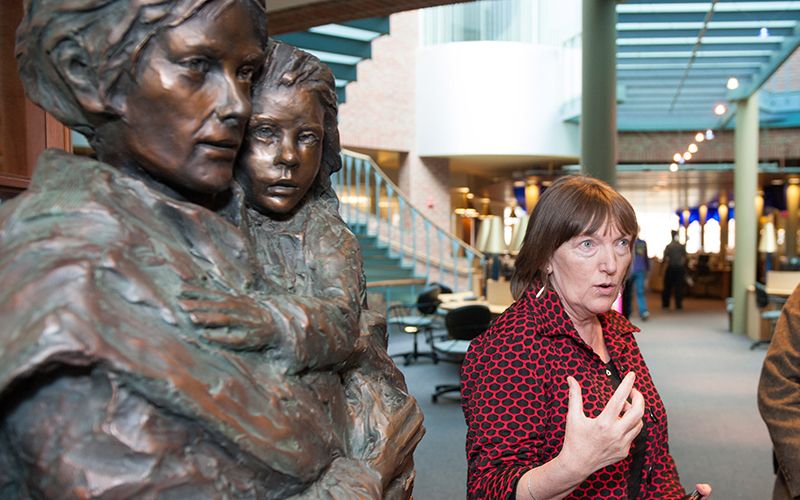Ireland's Great Hunger Museum, in Connecticut, will almost certainly close if no new sources of funding are found, due to the direction of new Quinnipiac University President.
Ireland's Great Hunger Museum, at Quinnipiac University in Hamden, Connecticut, will almost certainly close, at the direction of new President Judy Olian, herself the Australian-born daughter of Holocaust survivors, unless new sources of funding are found, sources have told the Irish Voice, which first reported the story on Wednesday morning.
In a statement, on Wednesday afternoon, which makes clear that Olian is expecting the museum to pay for itself, the university also confirmed the end of its involvement with the New York City St. Patrick’s Day parade.
“The university is in the midst of a rigorous and comprehensive strategic planning process around the critical priorities of student learning and institutional excellence. Given our many student-centric priorities, our hope is that Ireland’s Great Hunger Museum identifies diverse sources of support for its programs and initiatives, including philanthropy,” said Lynn Bushnell, vice president for public affairs at Quinnipiac.
“As for the parade, while we enthusiastically support its important goals and underlying spirit, we are redirecting university resources to more immediate needs that serve students on the campus.”
A source told the Irish Voice that Olian has “no interest” in the museum and that she wants it closed.
“She’s never said one supportive thing about the museum. And it will be hard to raise money if the president is sending out signals that she doesn’t care about it.”
Olian, who assumed the presidency last July after Dr. John Lahey retired after 31 years at the helm, also decided to end Quinnipiac’s sponsorship of the parade, which was $100,000 per year. The university has participated in the parade for 30 years, but that will end in 2019 as Olian refused to allow a Quinnipiac banner in the line of march – the cost of which is only $200.
The Irish Voice has learned that Lahey, who now lives in Florida, will return to Quinnipiac next week for a meeting with Olian to discuss the future of the museum which he opened in 2012. They have met only once before. Lahey, who built enrollment at Quinnipiac from 1,900 when he took over to nearly 10,000 and increased the endowment from $3 million to $530 million, will resume teaching philosophy at Quinnipiac in the fall.
In a brief interview with the Irish Voice, Lahey said that he is “not happy” that Quinnipiac is skipping this year’s parade.
“The sponsorship is one thing. That would be the decision of the president. But not marching makes no sense to me,” he added.
The Great Hunger Museum’s annual operating budget is roughly $350,000. Last year the Irish government gave the museum $100,000 to bring its Famine art – the most extensive collection of such works in the world. The exhibition “Coming Home: Art and the Great Hunger” have been touring Ireland - in Dublin, Cork, and Derry - and will end on March 16.
But raising funds to keep the museum open will be hard, multiple sources said, because of Olian’s obvious disinterest.
“When she went to the museum for the first time she said, ‘This is John’s museum,’” a source said.
“If potential donors see that the president doesn’t care, why would they want to offer support?”
Olian has not consulted with Lahey about the future of the museum or the university’s Great Hunger Institute helmed by the renowned Famine historian Dr. Christine Kinealy. She also withdrew from the New York City parade, which Lahey chaired for several years and served as grand marshal in 1997, without first informing him.
“It’s just incredibly disrespectful. John has had to learn about these things second hand. There’s no excuse for it. Is the school so hard up that it couldn’t afford $200 to allow the banner in the line of march?” a source said.
“The facts are that John put Quinnipiac on the map. It was a small, very local school when he got there, and now it’s hugely respected with students from all over the country.”
Lahey said the Great Hunger Museum is “incredibly important,” and can “teach valuable lessons.”
“Bigotry and hatred still exist today. We see it all the time. We can draw parallels to the history of the Irish, and the museum is there to tell the story of how the Irish persevered.”
The school’s affiliation with Ireland, sources point out, has been nothing but positive. Twenty percent of the student body is Irish American, and the study abroad program Quinnipiac has with University College Cork is the university’s most popular.

Quinnipiac University professor Christine Kinealy, director of the Ireland's Great Hunger Institute at Quinnipiac, (Via: qu.edu)
The school’s website also boasts about its Irish credentials.
“We have unique strengths when it comes to Irish history. Ireland’s Great Hunger Institute at Quinnipiac sponsors conferences, speaking events and courses that focus on the tragic Irish potato famine of the 1840s. And our Ireland’s Great Hunger Museum is a valuable resource for students interested in exploring art, sculpture and writings pertaining to the Famine. Through this program you’ll have opportunities to enrich your experience and earn credit through internships in both Ireland and in the U.S,” the website says under the Minor in Irish Studies section.
Former Congressman Bruce Morrison, who represented Connecticut’s 3rd District which includes Hamden from 1983-1991 and also holds an honorary degree from Quinnipiac, praised Lahey’s leadership and said it’s vital that the Great Hunger Museum remains open.
“John Lahey was an extraordinary college president who transformed Quinnipiac from an afterthought to a prestigious university. Part of his legacy is the museum which should remain forever an acknowledgment of the desperate battle the Irish fought to survive and become a huge part of the American Dream,” Morrison told the Irish Voice/IrishCentral.
“It is a universal lesson on just how much a people suffered, and how they eventually turned tragedy into triumph.”
Do you believe that Great Hunger Museum in Connecticut should be kept open, at all costs? Let us know your thoughts on the recent Quinnipiac decisions in our comments section below.
Read more: Famine victims had badly rotten teeth due to heavy smoking new study reveals




Comments